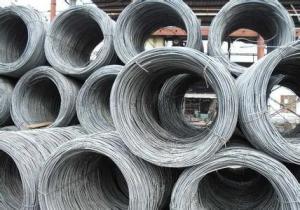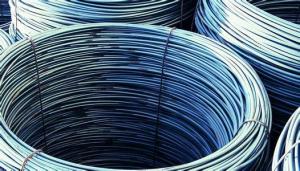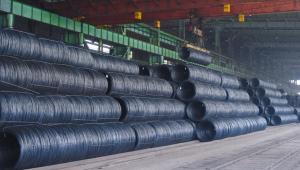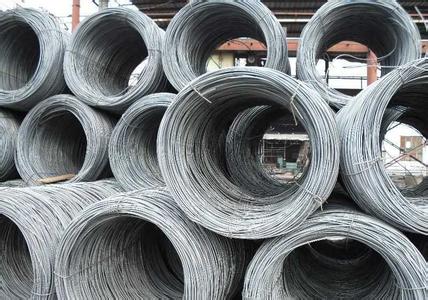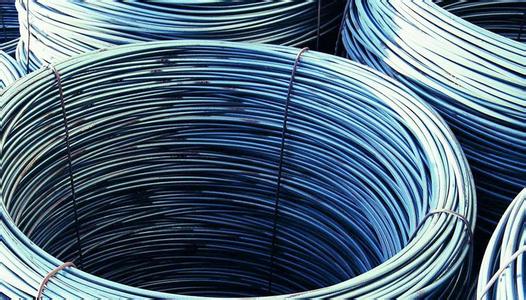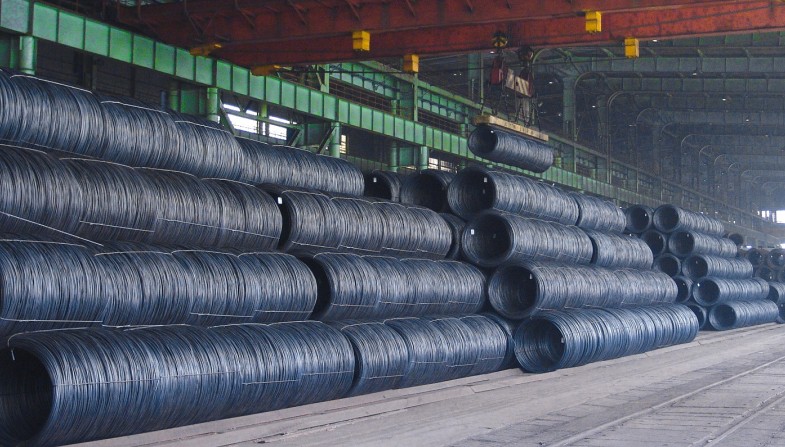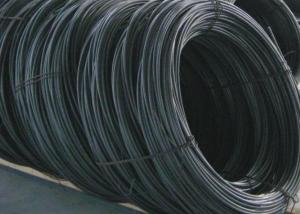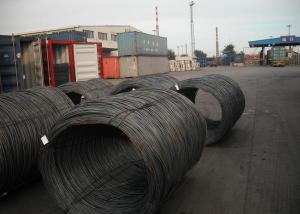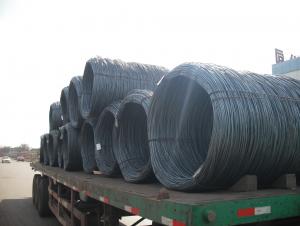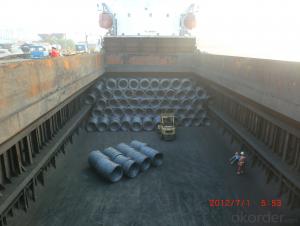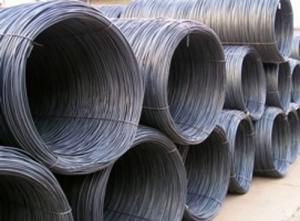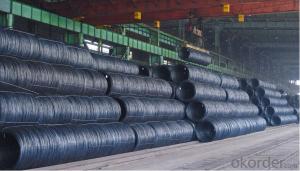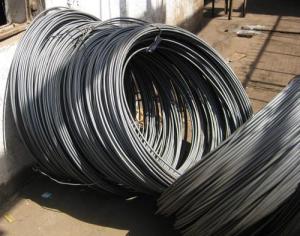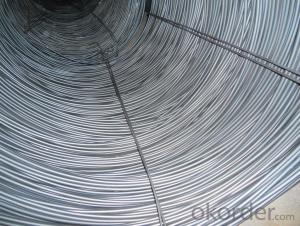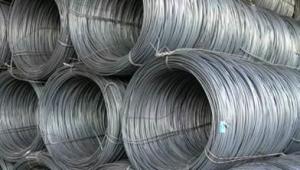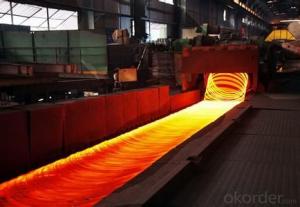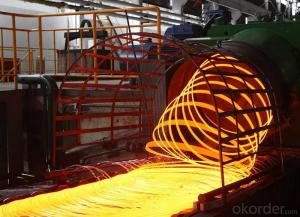Hot- rolled wire rod
- Loading Port:
- China Main Port
- Payment Terms:
- TT OR LC
- Min Order Qty:
- -
- Supply Capability:
- -
OKorder Service Pledge
OKorder Financial Service
You Might Also Like
Wire is 5-22 mm diameter hot rolled round steel, or rather the cross section of special-shaped steel. Due to the delivery of the goods in the form of wire rod, so it is also known as wire rod. Wire cross-section circumference is small, common specifications for 5-13 mm diameter. According to the different can be divided into the high speed wire rod mill (line) and ordinary wire line (at) two kinds.
classification
Generally made from ordinary carbon steel and high quality carbon steel wire rod. According to the directory and USES different steel distribution, mild steel wire including ordinary hot rolled plate, the high quality carbon steel wire rod, carbon electrode wire rod, conditioning threaded rod, wire rope with wire rod, piano wire with wire rod and stainless steel wire rod, etc.
1. Ordinary low carbon steel hot rolled plate (GB701-65), normal low carbon steel hot rolled plate by low carbon ordinary carbon structural steel or the carbon structural steel rolling of low yield point, is dosage the biggest, the most widely used in varieties of wire rod, also known as the cord.
Main use: general line is mainly used in construction of reinforced concrete structure for reinforcement, can also be made steel wire, cold drawn to pull for strapping, etc.
2. Ordinary no twist accused of cold, hot rolled low carbon steel wire rod (ZBH4403-88), no twist accused of cold, hot-rolled wire rod by no twist to control cooling after rolling in high speed wire-rod mill, material is the same as the general line, but no twist accused of cold, hot-rolled wire rod with high dimensional accuracy, good surface quality and higher mechanical properties, etc.
Main application: no twist accuracy of cold, hot-rolled wire rod size control points A, B, C level 3. A, B, C level precision is applicable to drawing, construction, packaging and electrode and other purposes, B, C level accuracy is suitable for processing into bolts, screws and nuts, etc.
3. Quality carbon steel wire rod (GB4354-84), high quality carbon steel wire rod is made of high quality carbon structural steel rolling. Is one dosage larger varieties of wire rod variety.
Main application: high quality carbon steel wire rod is mainly used for processing and manufacturing carbon spring steel wire, oil quenching tempering carbon spring steel wire, prestressed steel wire, high strength and high quality carbon structural steel wire, galvanized steel wire, galvanized wire rope, etc.
4. Quality carbon steel no twist accused of cold, hot-rolled wire rod (ZBH44002-88), no twist accused of cold, hot-rolled wire rod quality carbon steel by the high-speed wire mill rolling with no twist, disposed of by controlled cooling after rolling. Compared with the high quality carbon steel wire rod, high dimensional accuracy, good surface quality, have higher mechanical properties.
Main USES: the main purpose is the same as the high quality carbon steel wire rod. Often used in the manufacture of carbon spring steel wire, oil quenching tempering carbon spring steel wire, prestressed steel wire, high quality carbon structural steel wire, galvanized steel wire, etc.
5. Wire rope with wire rod (YB349-64), wire rope with wire rod is one of the high quality carbon structural steel hot rolled plate.
Main application: wire rope with wire rod available 35 and 40, 45, 55, 60, 65, 70, 75, 80 and 85 steel grade high quality carbon structural steel manufacture. Chemical composition meet GB699 (high quality carbon structural steel technical conditions).
6. Wire rope with no twist accused of cold, hot-rolled wire rod (ZBH44004-88), wire rope with no twist charged with hot and cold rolled plate and with high quality carbon structural steel, in the absence of torsion wire mill rolling, controlled cooling after rolling. This rolling of wire rod, high dimensional accuracy, good surface quality, superior mechanical properties.
Main application: mainly used for drawing steel and steel strand steel wire rope.
7. Carbon electrode steel wire rod (GB3429-82), carbon electrode made by high quality carbon structural steel hot rolled low carbon steel rod.
Main application: mainly used in the manufacture of manual arc welding welding core.
8. No twist accused of cold, hot rolled carbon electrode steel wire rod (ZBH44005-88), no twist accused of cold, hot rolled carbon electrode steel wire rod is rolling on blockade twist wire mill, and made controlled cooling after rolling. Its high dimensional accuracy, good surface quality, superior performance, is a kind of high quality welding rod steel wire rod.
Main application: mainly used in the manufacture of a coated electrode steel reinforced carbon steel hot rolled plate.
9. Alloy structural steel hot-rolled wire rod (GB3077-82), alloy structural steel hot-rolled wire rod by alloy structural steel rolling material. Alloy structural steel with a total of 26 steel group, the 78 steel grades. Each manufacturer according to buyer's requirements and different USES to choose brand for production.
Main use: alloy hot rolled wire rod structure is mainly used for drawing wire, metal products and components.
10. Carbon tool steel hot-rolled wire rod (GB1298-86), carbon tool steel by high quality or high quality high carbon steel rolling. Processing performance and wear-resisting performance is good, the price is cheap.
Main USES: mainly used in drawn steel ratio and making tools, etc.
11. Alloy tool steel hot-rolled wire rod (GB1299-77)
Alloy tool steels is in chrome is joined on the matrix carbon tool steel, tungsten, molybdenum, vanadium, silicon, manganese, nickel and cobalt alloy elements and tempered steel. Compared with the carbon tool steel. It has good hardenability, small heat cracking tendency, the characteristics of high wear resistance and heat resistance. Alloy tool steel hot-rolled wire rod by 33 five steel group steel grade of alloy tool steel material and rolled. Respectively by the dalian steel, benxi steel mills and steel mills and other unit production in shaanxi province.
Main use: is suitable for measuring tool, cutting tool and cold and hot die, shock resistant, etc.
12. Spring steel hot-rolled wire rod (GB1222-84)
Spring steel is used in the manufacture of springs or other steel grade of elastic element. Springs and elastic element mainly USES the elastic degeneration absorb and store energy, alleviate vibration, shock, or make parts to complete some action for the purpose. Since it is in shock, vibration or even under the working conditions of periodic alternating stress for a long time, so the spring steel with high yield strength, especially must have higher showed (the ratio of yield strength to tensile strength) and fatigue strength of high elastic, high resistance to high temperature and corrosion resistant performance. The surface of spring steel shall also have the good quality.
Spring steel with carbon spring steel and alloy spring steel, a total of 17 brands.
Main use: spring steel hot-rolled wire rod is mainly used in the production of various USES of helical spring.
13. Ball bearing steel hot-rolled wire rod (YB9-68), referred to as "bearing steel, ball bearing steel is used in the manufacture of various types of rolling bearing ring (sleeve) and steel rolling body (the ball). Due to the particularity of its USES for bearing steel has high and even hardness and wear resistance, high elasticity and fatigue strength. Enough toughness and hardenability, at the same time in the atmospheric environment or lubricant has certain corrosion resistant ability. Some special use of the rolling bearing also require high temperature resistance, corrosion resistance, nonmagnetic, ultra-low temperature, high precision, long life and other performance. So the choice of bearing steel and steel than ordinary steel strict quality.
Bearing steel is usually refers to the high carbon chromium steel, there are also carburizing bearing steel, high carbon chromium stainless bearing steel. Commonly used in rolling bearing steel hot-rolled wire rod steel grade five.
Main use: ball bearing steel hot-rolled wire rod is mainly used in the manufacture of bearing steel ball (ball), etc.
14. Stainless steel wire rod (GB4356-84), stainless steel wire rod was organized by a variety of brand different size of stainless steel hot rolling.
Main use: stainless steel wire rod is mainly used in the manufacture of stainless steel wire, stainless spring steel wire, stainless wire upsetting and stainless steel wire. According to the main industrial USES for to distinguish, stainless steel wire rod are stainless steel and stainless acid-resistant steel wire rod.
15. Welding of stainless steel wire rod (GB4241-84), welding of stainless steel wire rod and stainless steel wire rod is different in chemical composition. In order to guarantee its excellent welding performance, improve the quality of weld, welding of stainless steel wire rod in composition marked characteristics are low carbon, phosphorus, sulfur, less toxic impurities, such as nickel, chromium content is higher.
Main application: mainly used in the manufacture of welding electrode wire and steel core.
The production process
The editor
Commonly used wire line production.
A, through the step by step the billet heating furnace heated to above 1100 degrees Celsius;
Two, heating the billet, after high pressure water descaling;
Three, into the roughing mill rolling, roughing mill for the strip plant;
Four, after roughing rolled piece into the water for cooling, in order to control its internal microstructure;
Five, leave water cooling period after entering the mill and finishing mill for further rolling;
Sixth, after finishing the shape of rolled piece formed by spinning machine spit out volume;
Seven, volume of wire forward cooled in the air cooling section;
Eight, at the end of the air cooling section, wire rod by coil unit into drum shape;
After nine, with drum shape of baling wire into the baling machine;
Ten, into the shipping department.
- Q: What are the advantages of using steel wire rod in architectural applications?
- There are several advantages of using steel wire rod in architectural applications. Firstly, steel wire rod offers exceptional strength and durability, making it suitable for various structural elements such as beams, columns, and reinforcements. Its high tensile strength allows for the creation of lightweight and slender designs without compromising on strength. Additionally, steel wire rod is highly versatile and can be easily shaped, bent, and molded to meet specific architectural requirements. This flexibility allows for intricate and complex designs to be realized, enhancing the aesthetic appeal of architectural structures. Furthermore, steel wire rod has excellent corrosion resistance properties, ensuring longevity and minimizing maintenance costs. It can withstand harsh environmental conditions, making it suitable for both indoor and outdoor architectural applications. Lastly, steel wire rod is a sustainable choice as it is 100% recyclable. Its recyclability reduces the environmental impact and promotes a circular economy. Overall, the advantages of using steel wire rod in architectural applications include strength, versatility, durability, corrosion resistance, and sustainability.
- Q: What are the main factors driving the demand for steel wire rod?
- The main factors driving the demand for steel wire rod include the growth in construction and infrastructure projects, industrialization and urbanization in developing countries, the automotive industry's need for steel wire rod in manufacturing vehicles, and the increasing demand for electrical and electronic products that require steel wire rod for wiring and cables.
- Q: How are defects in processed steel wire rod detected and corrected?
- Defects in processed steel wire rod are commonly detected using non-destructive testing methods such as visual inspection, ultrasonic testing, magnetic particle inspection, or eddy current testing. Once defects are identified, they can be corrected through various methods like grinding, welding, or heat treatment, depending on the nature and severity of the defect.
- Q: How are steel wire rods used in the manufacturing of mesh screens for filtration?
- Due to their strength, durability, and versatility, steel wire rods are vital components in the production of mesh screens used for filtration. To obtain the desired diameter and strength, these rods undergo a series of steps including heating, rolling, and cooling. Once formed, the wire rods are woven or welded together to construct the mesh screen. Mesh screens made from steel wire rods find applications in various industries for filtration purposes. In the water treatment sector, for instance, they are utilized to eliminate impurities, contaminants, and solid particles from water sources. The steel wire rods provide the necessary tensile strength and corrosion resistance, ensuring the longevity and effectiveness of the mesh screen. Customization options are available for the size and spacing of the wire rods used in manufacturing mesh screens for filtration. Different mesh sizes allow for the filtration of various particle sizes, enabling the screens to effectively capture and separate solids from liquids or gases. The steel wire rods also provide stability and structural integrity to the mesh screens, enabling them to withstand high-pressure filtration processes. To enhance their filtration capabilities, steel wire rods can be coated with different materials. For instance, a polymer coating can be applied to prevent clogging and improve the efficiency of the screen. Additionally, the mesh screens can be further processed and shaped into different forms, such as cylinders, cones, or flat sheets, depending on the design and application requirements of the filtration system. In conclusion, steel wire rods are essential in the manufacturing of mesh screens for filtration. Their strength, durability, and adaptability make them an ideal material for creating mesh screens that effectively separate and filter contaminants from various substances. This ensures the quality and purity of liquids and gases in numerous industries.
- Q: How is steel wire rod recycled in a steel production facility?
- In a steel production facility, the recycling process of steel wire rods involves several steps to ensure efficient and sustainable reuse of this material. Here is a breakdown of the steel wire rod recycling process: 1. Collection and Sorting: The first step is to collect steel wire rods from various sources, such as scrap yards, demolition sites, or manufacturing plants. These steel wire rods are then sorted based on their quality and composition. Sorting allows for better control over the recycling process and ensures that only suitable materials are used. 2. Shredding and Fragmentation: Once sorted, steel wire rods go through a shredding process, which involves passing them through heavy-duty machines that break them down into smaller pieces. This fragmentation increases the surface area of the material, making it easier to handle during subsequent steps. 3. Magnetic Separation: After shredding, the fragmented steel wire rods undergo magnetic separation. Powerful magnets are used to extract any ferrous materials, such as iron and steel, from the mixture. This process effectively removes any impurities and contaminants, leaving behind clean steel wire rods. 4. Melting and Purification: The clean steel wire rods are then melted in a furnace at extremely high temperatures. This process, known as smelting, turns the solid fragments into molten steel. During the melting process, various additives and chemicals can be introduced to refine the steel's composition and properties. 5. Casting and Solidification: Once the steel has been melted and purified, it is cast into molds to form new steel products or billets. These molds can be customized based on the desired shape and size of the final product. The molten steel is poured into the molds and left to cool and solidify. 6. Rolling and Drawing: After solidification, the steel billets are subjected to rolling mills that progressively reduce their size and shape them into the desired final product, such as wire rods, bars, or sheets. Depending on the specific requirements, the steel may also undergo a drawing process, where it is pulled through a series of dies to achieve the desired diameter and shape. 7. Quality Control and Finishing: Before the final product is ready, it undergoes rigorous quality control inspections to ensure it meets the required specifications and standards. Any defects or imperfections are identified and corrected. Once approved, the steel wire rods are typically cleaned, coated, or treated to enhance their durability, corrosion resistance, or other desired properties. Overall, the recycling process of steel wire rods in a steel production facility involves collection, sorting, shredding, magnetic separation, melting, casting, rolling, quality control, and finishing. This comprehensive process ensures that steel wire rods are effectively recycled, reducing the need for virgin materials and promoting sustainability within the steel industry.
- Q: How are steel wire rods used in the production of barbed wire?
- Barbed wire relies heavily on steel wire rods, which are essential for its production. These rods undergo a transformation process to become the sharp and enduring barbs that adorn the wire. To achieve this, the rods are subjected to a series of machines that shape them into a twisted pattern, with evenly spaced barbs along its length. To ensure the effectiveness of the final product, the steel wire rods used in barbed wire production must possess specific properties. They must be robust, as barbed wire is commonly used for fencing and security purposes. Additionally, the rods need to be flexible enough to be molded into the desired shape without any breakage or loss of integrity. This becomes particularly important during installation, as the wire is often stretched. Any weakness or brittleness in the steel rods could result in the wire breaking or becoming less efficient as a security measure. Once the steel wire rods have been shaped accordingly, they are typically galvanized to enhance their durability and resistance to corrosion. This involves applying a protective layer of zinc onto the wire's surface, preventing rusting and extending the lifespan of the barbed wire. In conclusion, steel wire rods play a fundamental role in the production of barbed wire. They provide the necessary strength, flexibility, and durability to create effective fencing and security solutions. Without these rods, the production of barbed wire would be impossible, significantly impacting its various applications, from agricultural use to perimeter security.
- Q: What are the challenges faced by the steel wire rod manufacturers?
- Some of the challenges faced by steel wire rod manufacturers include fluctuating raw material prices, intense competition in the market, stringent environmental regulations, and the need for continuous technological advancements to improve product quality and efficiency. Additionally, the industry also faces challenges related to transportation logistics, maintaining a skilled workforce, and managing supply chain complexities.
- Q: How is steel wire rod used in the production of wire ropes for marine applications?
- The production of wire ropes for marine applications relies heavily on steel wire rod. Wire ropes, which serve various purposes in the marine industry such as mooring, towing, lifting, and rigging operations, are manufactured using steel wire rod made from high carbon steel. To create the final product, the wire rod undergoes a series of processes. Initially, the wire rod is drawn through dies, reducing its diameter and increasing its length. This wire drawing process is necessary to achieve the desired size and strength of the wire rope. After wire drawing, a lubricant is applied to the wire to improve its corrosion resistance and reduce friction during subsequent processes. The lubricated wire is then twisted together with other wires to form strands. These strands are helically laid around a core wire to create the wire rope. The core wire can be made of steel or a synthetic material, depending on the specific requirements of the application. The quality of the steel wire rod used directly impacts the strength and durability of the wire rope. The high carbon content in the wire rod provides the necessary strength and load-bearing capacity for marine applications. Additionally, the wire rod's resistance to corrosion is crucial in ensuring the longevity and reliability of the wire rope in harsh marine environments. Furthermore, the mechanical properties of the wire rod, such as tensile strength and ductility, play a significant role in determining the performance of the wire rope. These properties enable the wire rope to withstand heavy loads, resist deformation, and endure the dynamic forces encountered during marine operations. In conclusion, steel wire rod is a crucial component in the production of wire ropes for marine applications. Its high strength, corrosion resistance, and mechanical properties make it an ideal raw material for manufacturing wire ropes capable of withstanding the demanding conditions of the marine industry.
- Q: How are steel wire rods used in the manufacturing of wire brushes for cleaning purposes?
- Steel wire rods are used in the manufacturing of wire brushes for cleaning purposes as they serve as the core material for the bristles of the brush. The rods are typically cut and shaped into various lengths and gauges, and then attached to a handle or base to create a brush. The steel wire bristles are strong and durable, allowing the brush to effectively remove dirt, rust, and debris from surfaces.
- Q: What are the factors that affect the tensile strength of steel wire rod?
- The factors that affect the tensile strength of steel wire rod include the composition of the steel, the heat treatment process, the diameter of the wire, the presence of impurities, and the manufacturing technique used.
Send your message to us
Hot- rolled wire rod
- Loading Port:
- China Main Port
- Payment Terms:
- TT OR LC
- Min Order Qty:
- -
- Supply Capability:
- -
OKorder Service Pledge
OKorder Financial Service
Similar products
Hot products
Hot Searches
Related keywords
